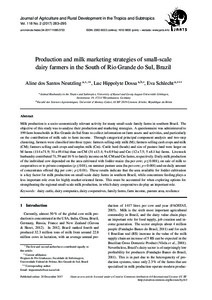Aufsatz

Production and milk marketing strategies of small-scale dairy farmers in the South of Rio Grande do Sul, Brazil
Zusammenfassung
Milk production is a socio-economically relevant activity for many small-scale family farms in southern Brazil. The objective of this study was to analyse their production and marketing strategies. A questionnaire was administered to 199 farm households in Rio Grande do Sul State to collect information on farm assets and activities, and particularly on the contribution of milk sale to farm income. Through categorical principal component analysis and two-step clustering, farmers were classified into three types: farmers selling only milk (M); farmers selling cash crops and milk (CM); farmers selling cash crops and surplus milk (Cm). Cattle herd (heads) and size of pasture land were larger on M farms (114 ±71.9; 51 ±49.4 ha) than on CM (31 ±13.4; 9 ±8.9 ha) and Cm (12 ±7.5; 5 ±8.1 ha) farms. Livestock husbandry contributed 71, 59 and 16 % to family income on M, CM and Cm farms, respectively. Daily milk production of the individual cow depended on the area cultivated with fodder maize (ha per cow; p ≤ 0.001), on sale of milk to cooperatives or to private companies (p ≤ 0.01), on summer pasture area (ha per cow; p = 0.001) and on daily amount of concentrates offered (kg per cow; p ≤ 0.01). These results indicate that the area available for fodder cultivation is a key factor for milk production on small-scale dairy farms in southern Brazil, while concentrate feeding plays a less important role even for highly market-oriented farms. This must be accounted for when exploring options for strengthening the regional small-scale milk production, in which dairy cooperatives do play an important role.
Zitierform
In: Journal of Agriculture and Rural Development in the Tropics and Subtropics. Kassel : Kassel University Press. - Vol. 118, No. 2 (2017) S. 283-295Sammlung(en)
Vol 118, No 2 (2017) (Journal of Agriculture and Rural Development in the Tropics and Subtropics (JARTS))Zitieren
@article{urn:nbn:de:hebis:34-2017110853733,
author={Neutzling, Aline dos Santos and Dossa, Luc Hippolyte and Schlecht, Eva},
title={Production and milk marketing strategies of small-scale dairy farmers in the South of Rio Grande do Sul, Brazil},
year={2017}
}
0500 Oax 0501 Text $btxt$2rdacontent 0502 Computermedien $bc$2rdacarrier 1100 2017$n2017 1500 1/eng 2050 ##0##urn:nbn:de:hebis:34-2017110853733 3000 Neutzling, Aline dos Santos 3010 Dossa, Luc Hippolyte 3010 Schlecht, Eva 4000 Production and milk marketing strategies of small-scale dairy farmers in the South of Rio Grande do Sul, Brazil / Neutzling, Aline dos Santos 4030 4060 Online-Ressource 4085 ##0##=u http://nbn-resolving.de/urn:nbn:de:hebis:34-2017110853733=x R 4204 \$dAufsatz 4170 7136 ##0##urn:nbn:de:hebis:34-2017110853733
<resource xsi:schemaLocation="http://datacite.org/schema/kernel-2.2 http://schema.datacite.org/meta/kernel-2.2/metadata.xsd"> 2018-01-02T12:47:53Z 2018-01-02T12:47:53Z 2017-12-20 1612-9830 2363-6033 urn:nbn:de:hebis:34-2017110853733 http://hdl.handle.net/123456789/2017110853733 eng Kassel University Press Urheberrechtlich geschützt https://rightsstatements.org/page/InC/1.0/ dairy cattle dairy companies dairy cooperatives family farms farm income pasture area resilience 630 Production and milk marketing strategies of small-scale dairy farmers in the South of Rio Grande do Sul, Brazil Aufsatz Milk production is a socio-economically relevant activity for many small-scale family farms in southern Brazil. The objective of this study was to analyse their production and marketing strategies. A questionnaire was administered to 199 farm households in Rio Grande do Sul State to collect information on farm assets and activities, and particularly on the contribution of milk sale to farm income. Through categorical principal component analysis and two-step clustering, farmers were classified into three types: farmers selling only milk (M); farmers selling cash crops and milk (CM); farmers selling cash crops and surplus milk (Cm). Cattle herd (heads) and size of pasture land were larger on M farms (114 ±71.9; 51 ±49.4 ha) than on CM (31 ±13.4; 9 ±8.9 ha) and Cm (12 ±7.5; 5 ±8.1 ha) farms. Livestock husbandry contributed 71, 59 and 16 % to family income on M, CM and Cm farms, respectively. Daily milk production of the individual cow depended on the area cultivated with fodder maize (ha per cow; p ≤ 0.001), on sale of milk to cooperatives or to private companies (p ≤ 0.01), on summer pasture area (ha per cow; p = 0.001) and on daily amount of concentrates offered (kg per cow; p ≤ 0.01). These results indicate that the area available for fodder cultivation is a key factor for milk production on small-scale dairy farms in southern Brazil, while concentrate feeding plays a less important role even for highly market-oriented farms. This must be accounted for when exploring options for strengthening the regional small-scale milk production, in which dairy cooperatives do play an important role. open access In: Journal of Agriculture and Rural Development in the Tropics and Subtropics. Kassel : Kassel University Press. - Vol. 118, No. 2 (2017) S. 283-295 Neutzling, Aline dos Santos Dossa, Luc Hippolyte Schlecht, Eva Gedruckte Ausg. im Verlag Kassel Univ. Press (www.upress.uni-kassel.de) erschienen. </resource>
Die folgenden Lizenzbestimmungen sind mit dieser Ressource verbunden:
Urheberrechtlich geschützt

